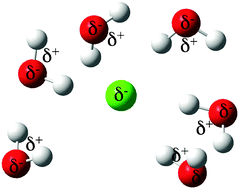Phys. Chem. Chem. Phys. 14, 7669-7678 (2012)
Fragment methods have been widely studied for computing energies and forces, but less attention has been paid to nonenergetic properties. Here we extend the electrostatically embedded many-body (EE-MB) method to the calculation of cluster dipole moments, dipole moments of molecules in clusters, partial atomic charges, and charge transfer, and we test and validate the method by comparing to results calculated for the entire system without fragmentation. We also compare to calculations carried out by the conventional many-body (MB) method without electrostatic embedding. Systems considered are NH3(H2O)11, (NH3)2(H2O)14, [Cl(H2O)6]−, (HF)4, (HF)5, (HF)2H2O, (HF)3H2O, and (HF)3(H2O)2. With electrostatic embedding, we find that even at the pairwise additive level a quantitatively accurate description of a system's dipole moment and partial charge distribution and a qualitatively accurate description of the amount of intermolecular charge transfer can often be obtained.
